In AutoSet mode, the device provides only the amount of pressure required to maintain upper airway patency. The AutoSet algorithm adjusts treatment pressure as a function of inspiratory flow limitation, snore and apnea. At the same time, the device analyses the state of the patients’ upper airway on a breath-by-breath basis and delivers pressure within the allowed range according to the degree of obstruction.
Available in the AirSense 10 AutoSet and AirSense10 AutoSet for Her devices.
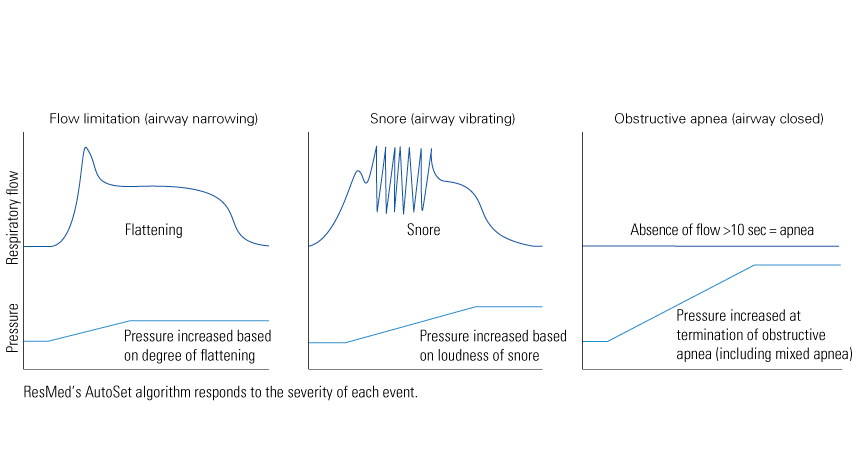
The pioneering new algorithm in the AirSense™ 10 AutoSet for Her is based on ResMed’s proven AutoSet algorithm and delivers therapeutic responses that have been tailored to the characteristics of obstructive sleep apnea (OSA) in women.
Research has shown that women with OSA have more upper airway resistance and flow limitation than the general OSA population1, which is why the AutoSet for Her algorithm has been designed to be more sensitive to flow limitation.
In addition, the algorithm provides more subtle changes in therapy pressure to minimise sleep disturbance. The AutoSet for Her algorithm also automatically adjusts the minimum AutoSet pressure if multiple apneas are occurring below a certain threshold.
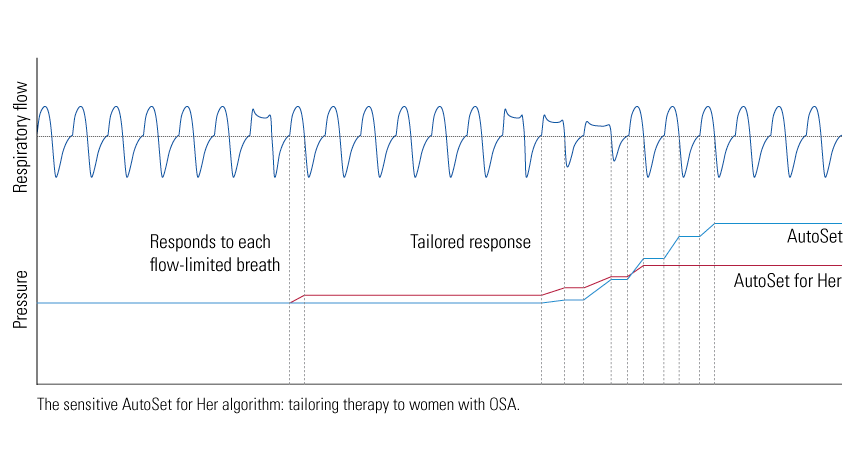
Continuous positive airway pressure (CPAP) is a type of therapy that delivers pressurised air at one fixed pressure throughout the night to keep your patients’ airways open so that they don’t stop breathing in their sleep.
Available in all AirSense 10 and AirCurve 10 devices.
S mode features a fixed pressure and is designed to deliver effective, comfortable therapy for a wide range of patients with respiratory insufficiency. In S mode, you may set two treatment pressures – one for inspiration (IPAP) and one for expiration (EPAP). The device senses when the patient is inhaling and exhaling and supplies the appropriate pressures accordingly. The difference between IPAP and EPAP levels helps determine the tidal volume. (For related features see Triggering and cycling, TiControl™ and Easy-Breathe.)
Available in the AirCurve 10 S and AirCurve 10 VAuto device.
Vsync is a leak management algorithm and the product of ResMed’s extensive experience in noninvasive ventilation (NIV). Vsync monitors and compensates for unintentional mask leak, so that patients receive their prescribed therapy pressure. Working with TiControl, Vsync ensures reliable breath detection (patient–device synchronisation) even in conditions of high leak.
Available in all AirCurve 10 devices.
The new AutoRamp feature with sleep onset detection helps make therapy comfortable from the moment the patient turns on their device. Built into ResMed’s AirSense 10 therapy devices, this ramp feature is activated automatically, so you’ll no longer need to spend time adjusting each patient’s ramp setting.
As soon as the patient turns on their device, AutoRamp begins – delivering a lower start pressure to help patients fall asleep with ease. Then, using its unique sleep onset detection capability, AutoRamp detects that the patient has fallen asleep, and then starts to comfortably ramp up to the prescribed pressure. So, patients receive their prescribed pressure from the moment they’ve fallen asleep.
With ramp times automatically adapting to each patient’s individual sleeping patterns, AutoRamp gives your patients a tailored start to therapy, and makes the most of every valuable moment of therapy time.
Available in the AirSense 10 Elite, AirSense 10 AutoSet for Her and AirSense 10 AutoSet devices.
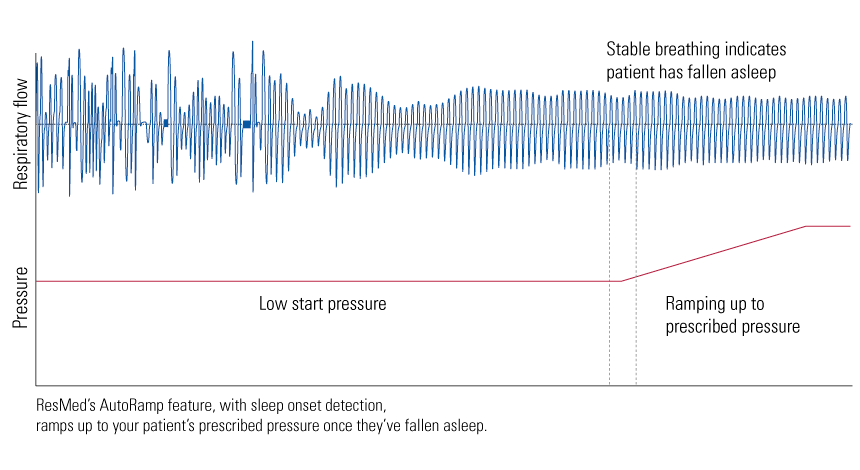
CSR is a form of sleep-disordered breathing characterised by a periodic waxing and waning of respiration. The waxing periods (hypopneas, typically 40 seconds in length) can include large gasping breaths that tend to arouse the patient while the waning periods (hypopneas or apneas, typically 20 seconds in length) cause blood oxygen desaturations.
ResMed’s new Cheyne-Stokes respiration (CSR) detection feature helps you identify patients on fixed or auto-adjusting pressure devices, but who may present with CSR breathing patterns. Throughout the night, the intelligent algorithm continually monitors a patient’s breathing patterns, checking cycle lengths and searching for representations of CSR.
Available in the AirSense 10 Elite, AirSense 10 AutoSet for Her and AirSense 10 AutoSet therapy devices.
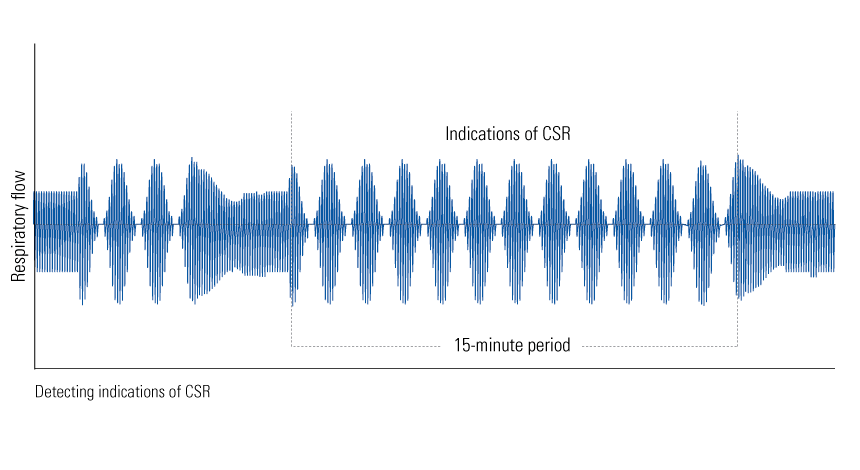
Central sleep apnea (CSA) detection uses the Forced Oscillation Technique (FOT) to determine a whether a patient’s airway is open or closed during an apnea. When an apnea has been detected, small oscillations in pressure (1 cm H2O peak-to-peak at 4 Hz) are added to the current device pressure. The CSA detection algorithm uses the resulting flow and pressure (determined at the mask) to measure whether the airway is open or closed.
Available in the AirSense 10 AutoSet, AirSense 10 AutoSet for Her and the AirSense 10 Elite.
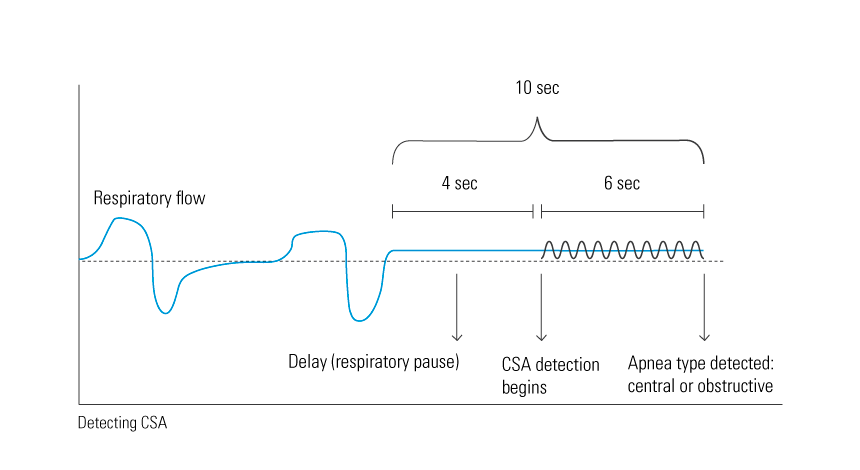
ResMed’s AutoSet algorithm now allows for additional customisation of therapy with the new AutoSet Response mode, which offers all the benefits of the enhanced AutoSet algorithm with gentler pressure increases for additional comfort.
For patients who are sensitive to faster changes in pressure during therapy, AutoSet Response can be set to either Standard or Soft. If set to soft, patients will receive gentler pressure rises during therapy.
Available in the AirSense 10 AutoSet and AirSense 10 AutoSet for Her devices.
Designed to make the beginning of treatment more comfortable, ramp is available in all modes. Ramp time is the period in which the pressure gradually increases from a lower, more comfortable start pressure to the prescribed treatment pressure.
Available in all AirSense 10 and AirCurve 10 devices.
Respiratory Effort Related Arousals (RERAs) are periods of increased respiratory effort leading to an arousal. Increasing respiratory effort will be seen as airflow limitation. These flow-based RERA events are logged and stored as summary and detailed data and can then be viewed in AirView, ResMed’s cloud-based patient management system.
Respiratory Effort Related Arousals (RERA) reporting is available on the AirSense 10 AutoSet for Her in all modes.
Available in the AirSense 10 AutoSet for Her device.
Designed to make therapy more comfortable, Expiratory Pressure Relief (EPR) maintains optimal treatment for the patient during inhalation and reduces the delivered mask pressure during exhalation.
Available in all AirSense 10 devices.
Under normal conditions, the device triggers (initiates IPAP) and cycles (terminates IPAP and changes to EPAP) as it senses the change in patient flow. Patient breath detection is enhanced by ResMed’s automatic leak management. In addition, the device has adjustable trigger and cycle sensitivity to optimise the sensing level according to patient conditions.
This function is available in bilevel devices, S9 VPAP S, S9 VPAP ST and S9 VPAP ST-A.
Unique to ResMed bilevel devices, Ticontrol allows you to set minimum and maximum limits on the time the device spends in IPAP. The minimum and maximum time limits are set at either side of the patient’s ideal spontaneous inspiratory time, providing a window of opportunity for the patient to spontaneously cycle to EPAP.
The minimum time limit is set via the Ti Min parameter and the maximum time limit is set via the Ti Max parameter.
TiControl’s Ti Max and Ti Min parameters play a significant role in maximising synchronisation by effectively intervening to limit or prolong the inspiratory time when required. This ensures synchronisation even in the presence of significant mouth and mask leak.
Available in S9 VPAP S, S9 VPAP ST and S9 VPAP ST-A.
Climate Control is an intelligent system that controls the humidifier and the ClimateLineAir™ heated air tubing to deliver constant, comfortable temperature and humidity levels during therapy.
When used with ResMed’s new HumidAir™ heated humidifier and ClimateLineAir heated tube, each device is designed to automatically deliver therapy at the most comfortable temperature and humidity levels—thanks to the enhanced Climate Control Auto option. There are no settings to change and no complicated menus to navigate.
For patients who want greater control over settings, however, Climate Control Manual lets the patient adjust the temperature and humidity to the setting that is most comfortable for them.
In Climate Control Manual, the tube temperature and humidity level can be set independently, however rainout is not guaranteed. If rainout does occur, first try increasing the tube temperature. If the air temperature becomes too warm and rainout continues, try decreasing the humidity.
If the air in the mask feels too warm or too cold, the patient can adjust the temperature to find what is most comfortable or turn it off completely. The tube temperature can be set to anywhere between 16-30°C.
The temperature sensor located at the mask end of the ClimateLineAir heated air tubing enables the system to automatically control the temperature of the air delivered to the patient. This ensures the temperature of the air delivered to the patient does not fall below the set minimum temperature, therefore maximising breathing comfort for the patient.
The humidifier moistens the air and is designed to make therapy more comfortable. If the patient has a dry nose or mouth, turn up the humidity. If the patient is receiving excessive moisture in their mask, turn down the humidity.
The humidity level can be set to Off or between 1 and 8, where 1 is the lowest humidity setting and 8 is the highest humidity setting.
For each humidifier setting, the Climate Control system delivers a constant amount of water vapour, or absolute humidity (AH), to the patient’s upper airway.
The humidifier and ClimateLineAir heated air tubing are controlled by the Climate Control algorithm to deliver constant humidity and temperature outputs. The system adjusts automatically to changes in:
Available in all AirSense 10 and AirCurve 10 devices.
Mohsenin V. Gender differences in the expression of sleep-disordered breathing: role of upper airway dimensions. Chest 2001; 120(5):1442-7.